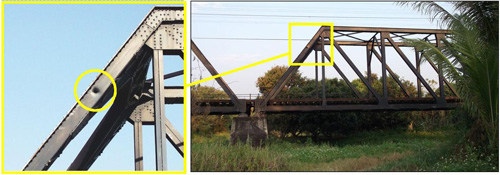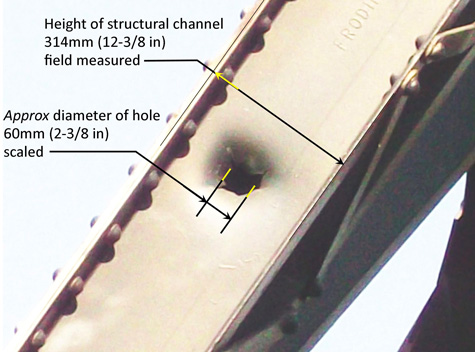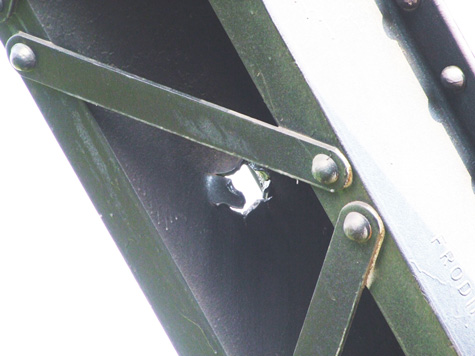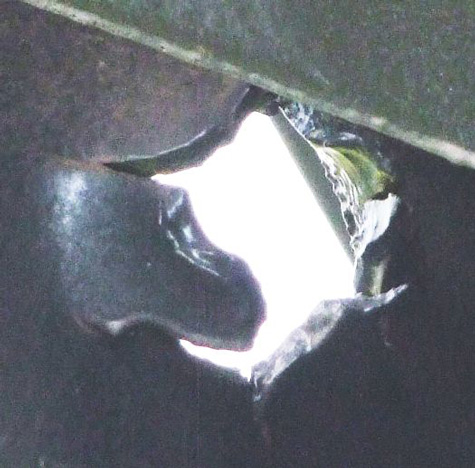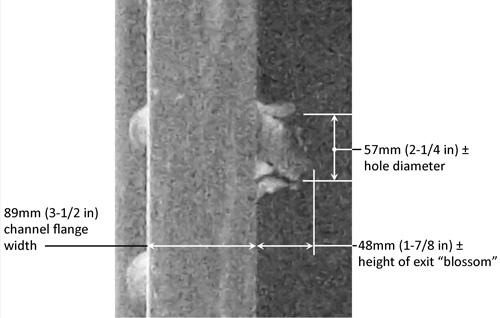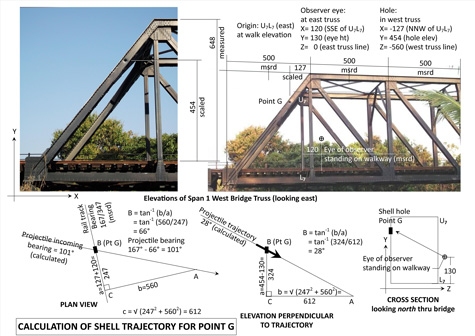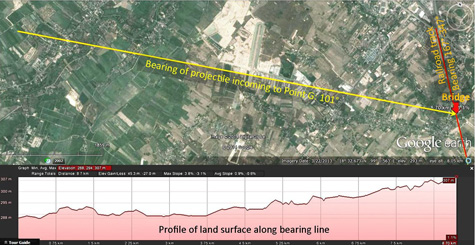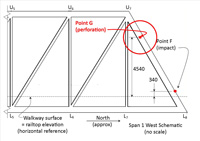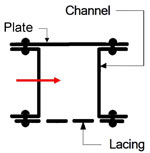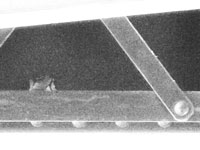| N 18°32.300 E 99°03.000 |
Ban San Khayom Bridge (Th: สะพานบานสันกะยบม / Jp: バンサンカヨム橋) Page 4 of 11 |
Railroad Sta |
| Text | Notes |
|
This is the third of three definite shell holes in the bridge: A projectile fired from generally WNW of the bridge passed through a 10mm (3/8 in) thick web of a structural steel channel in the west leg of the north portal frame of Span 1:[G01]
An enlargement of this image is available here. The horizontal bearing of the incoming shell was approximately 101° (compare to the 167° bearing of the bridge):[G07]
A rough guesstimate earlier thought that the the shot might have come from a Royal Thai Army (RTA) camp just southeast of Lamphun Town. With better precision, that possibility is ruled out. Nothing appears along the new bearing line which might suggest a source for the projectile. The vertical angle of the incoming shell was approximately 28° down. It was thought possible that, with the "knowns" of caliber, of horizontal and vertical angles of the shell hole, and of probable gun, existing trajectory curves might have been used to establish an at least tentative origin for the gun. Information on that gun however is sparse.[G07a]
In comparing Points A and G, the thickness of the steel target is the same at both locations, the plate at Point A and the channel web at Point G: both are 10mm (3/8 in). However, the Point G hole at 57mm+ (2.4 in+) evidences a projectile about three times the caliber of that at Point A with 22mm (7/8 in). So, in relative terms, the target at Point G was much thinner than that at Point A. The H/d ratio (plate thickness (H) vs projectile diameter (d)) is here, 10mm/57mm = 0.18; this is much smaller than the H/d ratio at Point A of 0.5. This may account for the classic petaling at Point G, which is missing at Point A. The clarity of the petaling effect where d values are much greater than H values, plus some indication of the shape of the projectile that caused Hole G, are given in this comparison of patterns for thin-plate perforations:[G08]
Holes produced by different projectile shapes, left to right: hemispherical, conical, and blunt. Hole G most closely resembles "conical", the center image. The most difficult problem about Point G is identifying a weapon with a caliber around 60mm.
An extended review of various alternative projectiles, included in Supplemental information, found the most likely source for the hole at Point G to be a 57mm caliber projectile. However, there is no record of any weapon having been used by either side in northwest Thailand that could have fired that projectile. With that caveat, the short list of weapons below includes only those judged possible: Allied Mosquito Mk XVIII Scenarios, admittedly strained, can be constructed most easily around the last item: 1. One of the main IJA supply routes supporting the Burmese Army followed the Thai railway from Bangkok to Lampang, 80 km southeast of San Khayom. There goods were transferred to road vehicles for transport onward to Kengtung, then the rail link at Meitkila, and in 1944 finally on to Imphal/Kohima, etc:[G09]
Transcription: . . . Reports of 19 Oct 44 state that each day fifty truck loads of Japanese material of war and troops leave from Lampang toward Burma. Those trucks follow the route from Lampang to [Chiang Rai], [Chiang Saen], Ban Chong, and Mong Len. . . . Starting in early 1944, Thai rail transport came under heavy attack by Allied aircraft (there doesn't seem to have been much recorded of attacks on road convoys).[G11] I'm guessing that those Allied air attacks might have damaged one or more tanks or their carriers sufficiently that they were abandoned along the way. Afterwards, enterprising Thais or Japanese might have salvaged a tank, or a tank gun, for anti-aircraft defense at Lamphun. The IJA 14th Tank Regiment participated In the attack on Imphal,[G12] and it was noted that at least one Type 97 medium tank was destroyed on the road just past Tengjoupal towards Imphal.[G13] Hence there were Type 97 medium tanks involved in the attack on Imphal, and those tanks, or some of them, may have been transported by some of the "fifty truckloads of Japanese materiel of war and troops" which reportedly left Lampang each day. 2. In preparation for defending Thailand very near the end of the war, various IJA units were assigned to the general Chiang Mai area to meet any Allied ground attack from the north. IJA units included elements of the 4th and the 56th Divisions as part of the 15th Army which was itself headquartered in Lampang. All were essentially in position by June 1945.[G14] These units might somehow have acquired Type 97 Medium Tanks (or at the least a Type 97 57mm Tank Gun), one of which found its way to the Lamphun area. If this scenario is to be fleshed in, then it is proposed that a 57mm gun was in the area for use as antiaircraft defense. When an Allied aircraft fired on a train approaching the San Khayom Bridge, the 57mm gun fired on the aircraft. Two 20mm shells from the aircraft hit the bridge. One shell from the 57mm gun fell short of its target, and instead hit the bridge. The weapon considered here, the Type 97 57mm tank gun, whether in a Type 97 medium tank or independently mounted, was known to have been designed for infantry support, rather than tank-vs-tank battles. The cannon was an unusually short barrelled weapon, 18.4 calibre (1.05m), with a low muzzle velocity of 255 m/s. Penetration was 25mm at 1,000m.[G15] I think it would be reasonable to assume that the gun's range could have been overestimated by a crew operating it in this abnormal application. The Handbook on Japanese Military Forces notes with regard to antiaircraft artillery:[G16] It has been emphasized to the Japanese soldier that effective antiaircraft defense depends on the use of all arms. Many of the weapons primarily designed for ground action and previously described under infantry armament also are designed to perform an antiaircraft role. Some gun models were titled as to their dual purpose: Model 96 (1936 type 2), 25mm antiaircraft-antitank automatic cannon and 40mm single and dual antiaircraft and antitank automatic cannon. During low level air attacks, it was routine for Allied and Axis troops on the ground in the European Theater to "dive for cover". But the Japanese tactic for troops on the ground countering such an air attack was quite the opposite as witnessed by Allied pilots: troops massed in assumed target areas to fire anything and everything, pistols, rifles, MGs, etc, at the attacking aircraft. IJA soldiers died as a result of this tactic; but some Allied aircraft were brought down that would have otherwise continued on unscathed.[G17] In that vein, an RTA-operated anti-tank gun brought down an Allied B-24 at Kaeng Luang Bridge on 21 November 1944. Details about the gun, particularly whether or not it might have been a dual purpose as described here, is unknown.
The hole at Point G records, as approximations, a diameter of 57-60mm, an angle of impact of -28°, and on a bearing of 101°. Everything else is, unfortunately, speculation. The hole is such a clean petaled perforation that it suggests it was the result of a comparatively large projectile (57mm) passing through the comparatively thin (10mm) steel member. However, there is no record of a 57mm gun having been in the area, either on the ground or in the air, during WW2. In fact, when the hole was made is unknown --- so it is not necessarily connected with WW2 action; but there does not seem to be any other realistic alternative.
As has sometimes been uttered, the whole can be greater than the parts. It does seem unusual that one bridge should show damage from three separate hits and that the three hits would not be related, and, at the same time, that this bridge is the only major railway bridge of six north of Lampang to display any shell damage. It seems feasible that Holes A and F were related: ie, they were caused by shells from either 20mm autocannons mounted on a Beaufighter or a 20mm autocannon on a P-38 during a single strafing run on a train entering the bridge. It would be consistent with a defense of rail traffic and / or the railroad bridge that fire from a land-based gun of 57mm caliber would have been directed at the shooting aircraft; in this particular instance, the resulting shell apparently fell short of the aircraft and instead hit the bridge to leave a permanent record. Finally, if a 57mm gun as noted in this scenario was in fact used for antiaircraft defense in the area, that would eliminate the possibility that the one known instance, on 06 March 1942, of an escort of Hurricanes flying over northwest Thailand having attacked the bridge: at that time, the Royal Thai Army was charged with providing antiaircraft support in the Chiang Mai-Lamphun area and it was equipped only with heavy machine guns (12.7mm) for that purpose.[G18]
Supplemental information section begins on next page
|
G01.^ Both photos look ENE at north end of Span 1. Left: extract DSCF1717.jpg of 02 Feb 2014; and right: extract of DSCF1885.jpg of 14 Feb 2014.
G02.^ Extract from DSCF1718.jpg of 02 Feb 2014. A similar steel channel, more accessible, was field measured elsewhere in the structure. As with Point A, the same portal frame detail applies; projectile path through section is shown as red arrow:
(adapted from Bridge Inspector's Reference Manual (Washington: National Highway Institute, 2006) Fig 8.1.6, p 8.1.6, by author using Microsoft Publisher)
G03.^ Extract from DSCF1721.JPG of 02 Feb 2014.
G04.^ Looking northwesterly and upward at shell exit Hole G; photo taken from walkway 1200mm south of vertical bridge member U7L7 with camera height of 1300mm (dimensions approx). See diagram below. Extract from DSCF9196.jpg of 02 May 2014 by Grant Wills. False coloring, notably the green, is present and resulted from enhancement using IrfanView.
G04a.^ Closeup of photo referenced above. Extract from DSCF9196.jpg of 02 May 2014 by Grant Wills. False coloring, notably the green, is present and resulted from enhancement with IrfanView.
G05.^ View is as described in text; the photo is extracted from DSCF1817.jpg of 06 Feb 2014:
and, enhanced:
G06.^ Photos extracted from (left and right) DSCF1721 of 05 Feb 2014 and DSCF1885 of 14 Feb 2014. Assembly, sketches, and annotations by author using Microsoft Publisher. An enlarged image is available here.
G07.^ Google Earth view of area west of San Khayom Bridge with "show elevation profile" option activated.
G07a.^ Wagner57 advised such a quest was impossible with data from a single shot (axishistory forum post 14, 1304 23 Sep 2014), and Williams tended to confirm post 15, 1544 23 Sep 2014). In an earlier message, post 8, 0322 01 Jan 2007, Williams noted that the ammunition for the IJA 57mm tank gun: 57x121R has a tiny cartridge case compared with other rounds of this calibre - it was a very weak round. Wikipedia: Type 97 57mm Tank Gun: The cannon was a short barrelled weapon with a relatively low muzzle velocity. G08.^ K. M. Kpenyigba, Tomasz Jankowiak, Alexis Rusinek, Raphaël Pesci,
G09.^ "Siam-Roads & Railroads" item dated 21 Oct 1944, in Road and Railroad Communications Report: Asiatic Area, 1-15 Nov 1944 (New Delhi: Joint Intelligence Collection Agency) (USAF Archive microfilm reel A8044 p0188). G10. (deleted).
G11.^ Referenced needed.
G12.^ Wikipedia: Battle of Imphal: Japanese Plan. G13.^ Allen, Louis, Burma: The Longest War 1941-1945 (London: Phoenix, 1984), p 222.
G14.^ Thailand Operations Record: Japanese Monograph No 177 (Headquarters: Army Forces Far East, 1953) (pp 34-35.
G15.^ Wikipedia: Type 97 57mm Tank Gun. As a comparison, its replacement, the Type 1 47mm gun, had a 53.8 calibre (2.53m) long barrel, a 830 m/s muzzle velocity, and a 41mm penetration at 1,400m. (Wikipedia: Type 1 47mm Anti-Tank Gun) G16.^ Isby & Ethell, ibid, p 229.
G17.^ Reference needed.
G18.^ Wisarut Bholsithi email of 1719 28 Apr 2013.
|
